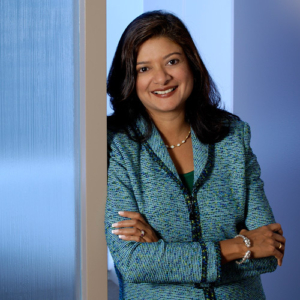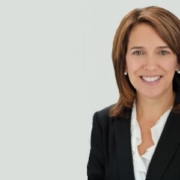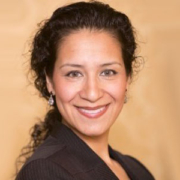Thought Leaders: Ranji Nagaswami on Leadership, Investing, and Managing Your Career
 “I am very concerned and alarmed at issues of financial integrity,” began Ranji Nagaswami, former Chief Investment Advisor to Mayor Bloomberg and the City of New York when asked about what institutional investors see as the important issues facing the buy-side.
“I am very concerned and alarmed at issues of financial integrity,” began Ranji Nagaswami, former Chief Investment Advisor to Mayor Bloomberg and the City of New York when asked about what institutional investors see as the important issues facing the buy-side.
Nagaswami spent over two decades successfully climbing the ranks of the investment management industry in the private sector. Then, in 2010, she took a job with Mayor Michael R. Bloomberg in the City of New York (NYC), where she would work on solutions to one of the administration’s biggest challenges: pension funding and managing investment risks of the NYC Retirement Systems’ $120 Billion plus in pension assets.
She was tasked with illuminating the administration and NYC Pension Board’s understanding of the drivers of the current pension crisis and successfully persuaded various stakeholders (with contentious mutual relationships to say the least), to restructure New York’s pension investments policy with an eye toward better balancing the long term risks. Having seen the buy-side from the unique vantage points of a manager and an institutional investor, she sees the need to change the tone of leadership in the investment industry as a whole as critical to furthering the interests of beneficiaries and shareholders – who, she says, “after all we are all in the industry to serve.”
“For over a decade now there have been deep issues surrounding our conduct as investment and financial services professionals. It is not just the conduct of the few who epitomized the worst behaviors during the accounting / insider trading / mortgage lending / leverage induced scandals, I am talking about all investors – research analysts, portfolio managers and financial advisors who bear our share of responsibility through our collective complacency in failing to enforce higher standards of due diligence and fiduciary behavior,” Nagaswami said. “We need to set a higher bar, a far more robust code of conduct for the asset management industry that sees improving end-investor outcomes as its ultimate mission. But to build a higher ethical culture we need leaders in the asset management industry who hold themselves accountable on this dimension. Thinking through standards to create accountability is deeply linked to the future of finance.”
“We need leaders who have the right values and prioritize integrity over asset gathering and profits.”
She added, “These may sound like easily said platitudes, but to many thoughtful investors it is very real and goes to the core of rebuilding confidence in the US financial system.” Nagaswami sits on the CFA Institute’s Asset Manager Code of Conduct Committee, but also uses her many public speaking opportunities to drive this issue home.
Career Path in Investment Management
Nagaswami grew up in India, where she spent her teenage years training and performing as a classical Indian dancer even as she excelled academically in undergraduate business studies at the University of Mumbai. “Training as a dancer was rather similar to the lives of US collegiate athletes, it’s how you define yourself in those years, it is how you spend your time,” she said. But ultimately, her curiosity and interest in business led her to choose a different path. She enrolled in the MBA program at Yale – even though she’d never had a job outside her dancing career. “It was a very unorthodox way of doing things,” she recalled. “I was the youngest person to enter and graduate from the Yale School of Management. Equally accidental was my first summer internship in investing that led to a full time career in an industry that I could never have predicted I would survive and thrive in for 27 years.”
Upon completing her MBA in 1986, she joined the Chase Manhattan Bank’s investment arm which ultimately became part of UBS Asset Management as a quantitative analyst within the fixed income team, and took on more and more responsibility until she eventually was named to be the Head of the Fixed Income Unit ten years later. In 1999, she left to join Bernstein just six months before the firm merged with Alliance Capital.
Offered the opportunity to move into the Value Equities team, she seized yet another unorthodox opportunity to broaden her investment skills. “Joining the Bernstein Value Equity team led to the happiest four years of my investing career,” she said. Through out her first 18 years as an analyst, portfolio manager, and team leader, Nagaswami’s roles included multiple investment and leadership challenges: profit and loss responsibilities, building investment teams, building a profitable business, managing and marketing to clients, and of course, generating alpha for clients.
In 2004, she embarked on an even bigger challenge when asked to help turn around AllianceBernstein’s mutual funds arm which invested $180 billion in funds for retail investors around the world. The division’s prior leaders had been asked to leave following a much publicized industry wide trading scandal. “It was one of the hardest things I’ve done in my professional life,” she recalled. The business had a difficult brand as a product/profit rather than client focused firm, antithetical to everything Nagaswami had tried to create in her own leadership efforts. But she was up for the challenge.
She was named Chief Investment Officer of the mutual fund division. Just how hard was this turnaround? As Nagaswami described, “On assuming the AllianceBernstein Mutual Fund Division CIO responsibilities in 2004, I met with Morningstar’s research team – possibly the most important thought leaders in the personal investing part of our industry. To my utter dismay the head of the team matter-of-factly told me that I had just taken on leadership of one of the “worst managed mutual fund families for shareholders.”
Three years and a lot of hard work later, Morningstar’s analysts voted to have Nagaswami as keynote speaker at their annual investor conference. This time, the same Morningstar Research team head introduced her as the CIO who had helped transform AllianceBernstein in to one of the mutual fund families that had best transformed itself following the crisis in the industry. “It was the proudest moment of my career up until that point for me. My team’s role as part of the turnaround was to help drive the reshaping of the brand from a short term asset gathering product shop to an investor outcomes focused and research led investment brand. It was really about aligning the products and marketing effort with an unrelenting value and mission of doing what is right—and persuading a lot of stakeholders to do things differently. While difficult, it was exhilarating to help raise an entire division to a higher sense of purpose while improving financial results.
“Shaping and driving real change is the hardest yet most interesting thing to do. Leaders who want to drive transformational change have to be sure of who they are and what their goals are then have the zeal to drive that change thru all the layers of an organization – while being open minded to the many ways they may be wrong.”
In 2008, after the market collapsed, AllianceBernstein was restructured, and the CEO departed. Nagaswami also left the firm. And she decided to approach her next chapter with the same passion and purpose that had yielded the great results at UBS and AllianceBernstein.
“At that point in my career I had been in the private sector for 23 years,” she explained. “I had begun to define myself not just as an investor and business leader but as a problem solver and change agent. And if you go back to the terrible financial crisis of that period with its grave systemic risks, I was driven by the idea that the most important problems to solve were in the public policy arena.”
It was this desire to engage with some of our country’s most intractable problems related to the financial sector and markets that let to her joining Mayor Bloomberg’s administration as Chief Investment Advisor for New York City’s $120 billion plus pension retirement system, the largest municipal pension system in the world. She dove into the cultural and political issues surrounding pensions and investments for the next two years. “The mandate for the newly created Mayor’s Office of Pensions and Investments was to help improve the returns and manage risks of the Retirement Systems’ investments while reducing the pension funding costs to the tax payer. It was a mandate to bring change to a model that had operated in a certain way for a very long time. It took a tremendous amount of understanding not just of investing but more importantly of how to navigate an extraordinarily complex political environment and help manage the commitments of the City to its employees at a time of significant financial stress for the overall City budget.”
Ultimately she was successful in driving a significant restructuring of the retirement systems investment policy, a bold plan that was adopted by a sometimes fractious group of nearly 60 trustees across multiple plans. “My team may have researched, designed, educated and persuaded our Fellow Trustees but everyone involved shares the credit for embracing the restructuring, for being open to understanding the risks in the portfolio and moving to a far more balanced approach to the strategic asset allocation policy despite tremendous differences in political views and stakeholder agendas.”
Learning Patience
When asked about lessons learned in looking back over her career, Nagaswami readily acknowledged that she should have adopted a more patient outlook when she was younger. “Life is an accumulation of all your experiences, great success only comes over time from your cumulative hard work and results,” she said.
She continued, “an important lesson is not to get ahead of one’s abilities in terms of worrying about one’s future career path. I think I had a mix of impatience and ambition that did not always serve me well.”
“If I were starting in my career, I would know and trust that success follows hard work. Building meaningful mentor and peer relationships, always raising my hand for difficult assignments and delivering on complex projects allowed people to see what I was capable of,” she explained.
Equally, she says that spending even more time trying to understand what my colleagues were like as individuals, deeply understanding their abilities and biases would have helped to foster the kind of teamwork needed to navigate competitive and organizational realities. “Building one’s leadership skills within complex investment organizations isn’t always easy and it requires an understanding not just of business strategy and markets but of the need for constant communication and understanding of human nature. There were will be moments that are really hard but it all adds up to something quite remarkable and worthwhile over time.”
Problems with Financial Sector Leadership
Nagaswami elaborated on her concerns about integrity in the financial sector. “The sell-side has become extremely transaction-based and short term profit seeking even as it serves a critical function in a capitalist system of raising capital to finance industry while creating mechanisms to manage risks. Short-termism is a buy side problem too, more and more firms are focused on asset gathering rather than generating superior investment results and growing beyond their abilities to add value for clients. On the buy-side you can and must never forget that your investment results are needed to provide for real human needs: for people’s retirements, for our kids’ college educations — and that is an extraordinary responsibility. But as I said at the onset, I despair that at too many firms this purposeful mission is far removed from the business of growing the firm.”
Relating this to her personal journey she added, “As a leader on the buy-side I was encouraged to work toward improving client outcomes and thinking long term. I have sought and built my career in buy-side firms that had thoughtful, nurturing cultures, where leaders groomed people to succeed for clients over a long period of time not maximize profits in the short term. I will personally always be grateful to industry legends like Lew Sanders, CEO at Bernstein for not just deepening my investment understanding but also for shaping my moral compass by encouraging everyone at the firm to deeply believe in our investment principles and focusing on improving investor outcomes.”
Women in Investment Management
Nagaswami says that some parts of the investment industry are well suited for women, while others can be extremely difficult. “Capital markets related financial services as an industry can be very challenging, the buy-side I have found, is a wonderful place for women to work. There are very different cultures on the sell-side versus the buy-side. I realized early on that I was onto something very cool.”
That’s not to say that a career on the buy-side is easy, though. “In the early years especially, the hours can be demanding. You really can not come to investing or markets related careers for a nine-to-five life. You have to be prepared to work extraordinarily hard, and will encounter 60 or 70 hour weeks in the early years.”
Nagaswami advises women beginning their careers in investment management to find a balance between humility and confidence. She explained, “This industry is just hard. But everything really worth doing in life is usually hard. Getting good in this industry means you have to be committed to being here a long time. The thing about markets is how little anyone really knows. Markets have a way of humbling the cleverest prognosticator. The best investors I know have tremendous humility and are constantly trying to understand the economy and markets better. At the same time one needs confidence – to believe that your carefully considered research or insights have led to insights that the market just does not see yet. The need for ‘Confident Humility’ has been a motto I have preached to anyone who has worked with me for a very long time.”
When it comes to the work/life balance conversation, she continued, “I don’t think there is a right answer that applies to every woman, it can be very difficult to ‘have it all.’” But, she continued, it is possible to create a balance that works for you. “My husband and I have a very supportive marriage that has sustained me though my career. Any career where so much is expected of you can drain you and perniciously impact other parts of your life, so loving, mutually respectful relationships with a significant other becomes very important.”
She also suggested that women think carefully about how they spend their time when they are with their families and think thru the trade-offs early. “Early in my career, I decided I was going to work longer and harder so I could find the economic means to have someone to clean and help around the house – just so I could spend my precious free time with our children. I fully acknowledge that not everyone can afford to think about this as an option, but finding ways to out-source daily chores so that you can spend even a bit more time with your kids is something that does not cross many working women’s minds.”
“The other thing I would re-do if I could is to work much closer to my home and skip the commute, even if it meant sacrificing a yard for my kids to run around in for a city life – just so I could have been far more involved in my children’s school and extra-curricular lives,” she added.
In Her Personal Time
Outside the office, Nagaswami enjoys thinking, speaking, and writing about transformative change. “I’ve had a lifelong interest in how to bring about change in society, to business leadership and to solving our societal problems by developing the field of social entrepreneurship. My husband (who teaches a class on Social Enterprise at Yale Unviersity) and I are deeply committed to this.”
She continued, “Social change comes because someone has the courage of their convictions to walk away from a career making money to take on the far riskier path of working to make a dent in our fundamental societal problems. These brave individuals who shape society are willing to take risks and make sacrifices. Helping to find these heroes in every society, to support them and help them understand market mechanisms so that the change they are working on can be self- sustaining and not aid/philanthropy dependent is a critical mission of my husband’s and my life.”
Through out her demanding career, Nagaswami herself has been and continues to be involved in social entrepreneurship organizations like Ashoka, VisionSpring, and African Leadership Academy.
The Influences that Shape her Life
Among her most life-defining relationships she counts her years at and her engagement with her business school alma-mater the Yale School of Management (SOM) as well as her more recent Fellowship at the Aspen Institute where she is a Henry Crown Fellow. “Yale SOM and the Henry Crown Fellowship have both defined the best of what I value in our leaders and in creating a good society, to define the highest standards for ethics, personal responsibility and for the imperative I feel to make my small dent in this world.”
Nagaswami is now a Moderator for the Aspen Seminars, a role she relishes because it allows her to share the time-tested principles of Aristotle, Plato, Locke, Aurobindo, and Machiavelli, with business leaders who need to think even harder about their leadership values and responsibilities. “There is such richness in the ideas of these great thinkers about the historical roots of contemporary business problems. They force you to think about your own moral compass on how you personally balance seemingly competing values like liberty versus equality or the individual versus the community that so polarize our political and social discourse today. My advice to every young person or business leader on understanding what really matters in this world is the same – go back and read the Great Books to understand the ideas of liberty and equality, of efficiency and community. Use these as your touch stones to then go on and think about the role you will play in shaping society – whether you define your impact as changing your own life or helping others.”
“As a good friend once said, the most important decision you can make is in choosing how to spend your time. I relish spending my time trying to understand reality and myself by testing myself in different ways, from a career and personal perspective. The more mature one gets the more we begin to understand that the real journey in life is most importantly the journey inward, to examine one’s own life and values to understand one’s true nature. For me, meditation and time spent in quiet contemplation have really helped me begin to understand what is possible for any one human being to do and be – but just barely.”
But above all, says Nagaswami, the greatest joy in her life is the time she spends with her family. “My family is everything to me. My husband is my best and most cherished friend, my consigliore, and the Chair of my personal Board of Directors. Our two beautiful children do not just bring the greatest joy to our lives but as they have grown in to the wonderful adults they are, they in turn are shaping me.”
She ended by saying, “Of all the elements that constitute my fully-lived life, I am most grateful to lead a life filled with purpose and self-awareness, friendship and laughter.”
By Melissa J. Anderson (New York City)






